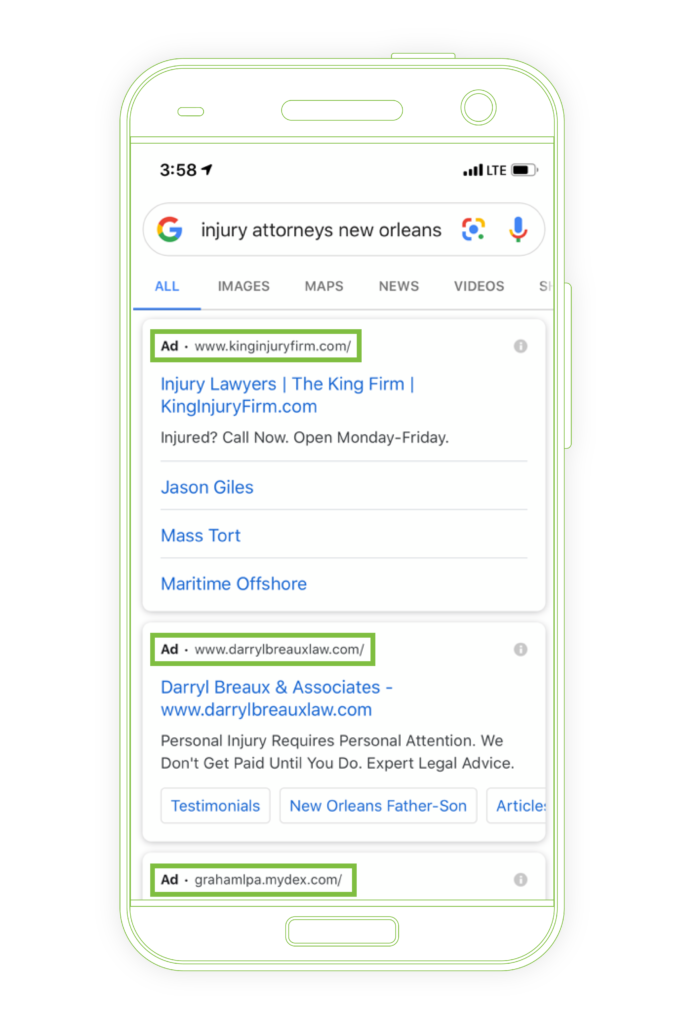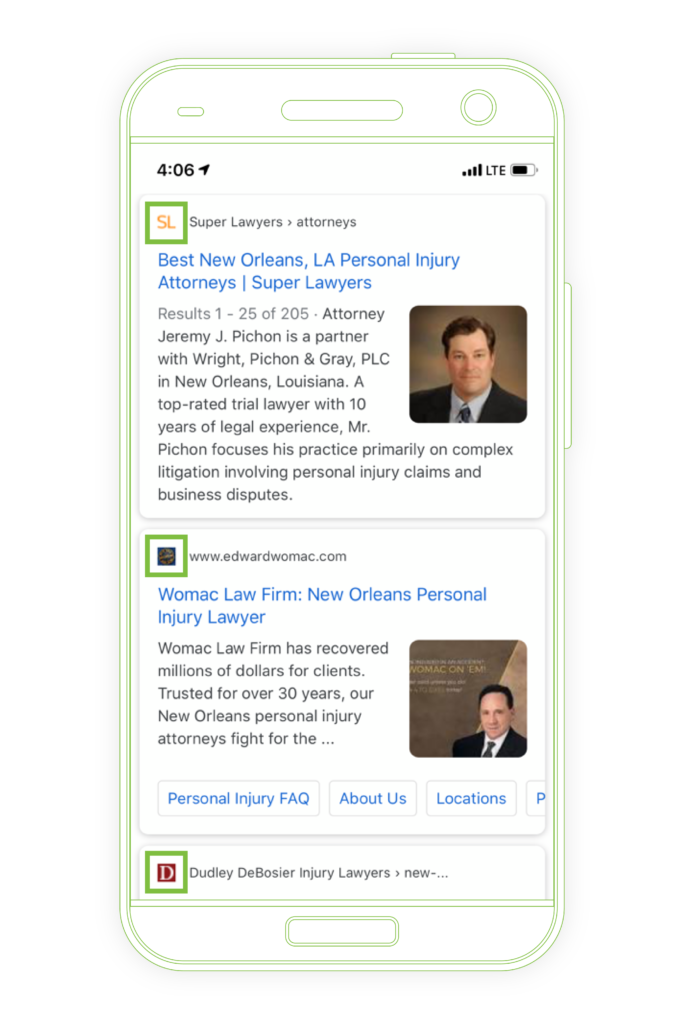Web Design

If you’re an attorney, achieving high rankings within Google’s organic results is one of the best ways to drive traffic to your website and ultimately, bring new business to your law firm.
You may have taken some time in between client meetings to Google keywords related to your business to see how you stack up to the competition. You see that you’re on page one, and think you’re doing pretty well. But if you only ever check your rankings on a desktop, you’re missing an important part of the story.
We often see that lawyers can overlook the importance of mobile. In order to excel at attorney SEO, you must focus your law firm’s digital marketing efforts on optimizing for mobile devices. That means creating content that is both informative and useful, but that reads well on a small screen. It means mobile-friendly website design. It also means understanding how your organic listings appear on Google’s mobile search results.
In late May, Google began rolling out changes to the way their mobile search results appear. There were two major changes:
- Black Ad Labels
- Favicons for Organic Results
Black Ad Labels
Most Google search results are comprised of both paid and organic listings. Paid placements have always been marked as such, but Google often tests new ways to display how ads appear. In their most recent update, paid search ads appear with a black ad label.
Favicons for Organic Listings
Scroll to the organic listings, and you’ll notice the second update: favicons. Favicons are the small icons that now appear next to the URL on organic listings.
During testing, Google claimed that the favicons make it easier for users to scroll through organic results more quickly.
Along with the update, Google released favicon guidelines. If your website’s favicon violates guidelines, Google will simply remove it from search results. If you see your law firm website in search results and you either do not have a favicon, or it’s not correct, you can have your website developer update your law firm’s favicon.
What Does This Mean for My Law Firm’s SEO Strategy?
Google is often subject to scrutiny over the ethics of how clearly they mark the paid ad results.
Over the years, we have seen organic search results lose real estate to paid ads, and paid ad labels become less distinguishable. Most SEOs agree that the new ad label blurs the lines between paid and organic results, and that the average user may not understand the difference.
For attorneys, this can be especially frustrating. Paid search campaigns can be expensive in the legal industry, and it may not be feasible for a smaller firm with a limited marketing budget.
While we understand and share this frustration, we know from experience that changes in Google’s ad labeling rarely has significant effects on organic performance.
Will This Impact My Law Firm’s Paid Search?
It’s possible, but we suspect it’s unlikely to cause any significant changes. One popular opinion is that some users do not trust paid search results and opt to click through to organic results that seemingly have earned their Google placement, rather than paying for it. If the distinction between ads and organic listings becomes less clear, it’s possible that more users will click on ads unknowingly.
Should I Be Worried?
At Postali, we have been managing attorney PPC and SEO campaigns for years, and have seen countless changes to mobile search result layouts. In general, we have found that they don’t cause significant changes to a law firm’s SEO or paid search strategy.
Whether it’s done in the best interest of users or not, Google is constantly changing the way mobile search results appear, and oftentimes will test new ad labels. Reacting to every update simply isn’t a productive use of your time. If your law firm focuses on running effective PPC campaigns and white hat SEO, your strategies should stand the test of time and be fairly agnostic to Google’s layout changes.
If you do see that click-through rates on organic listings are declining due to layout changes, it’s possible to offset with more emphasis on local SEO, improving your organic rankings, or identifying content gaps within your law firm’s website.
What Should I Keep an Eye Out For?
While we don’t recommend being overly reactive to Google’s mobile layout changes, it is important to keep a pulse on how it may be affecting your results. You should be looking at SEO and PPC data at least monthly, but after algorithm updates or mobile layout changes, it’s best to do weekly checks on your key performance indicators (KPIs).
It’s important to remember that the impact of the layout to your firm’s business depends largely on the percentage of traffic your website receives from mobile and desktop. For most practice areas, your mobile traffic may be around 50-60% of total website traffic. If your website receives a higher percentage of traffic on desktop, you’re less likely to see any notable shifts in performance from the mobile SERP (search engine results page) update.
To understand impacts to your organic search performance, your law firm’s marketing team or agency should monitor Google Search Console for shifts in click-through-rate on mobile devices. While it can sometimes be difficult to pinpoint correlation vs. causation, this is a good starting point.
Reach Out To Postali to Learn More
While it’s critical to keep up with Google’s tests and changes, it should not deter from the core pillars of your strategy. If you focus on attracting the right people to your law firm’s website, providing them with relevant and useful content and encouraging them to contact your firm, your digital marketing strategy will be poised for success.
To learn more about Google’s new mobile layout and how it might affect your law firm’s website, call Postali at 614-556-4618, or reach out through the online form.

Not sure where to begin?
Get started with a marketing audit.


